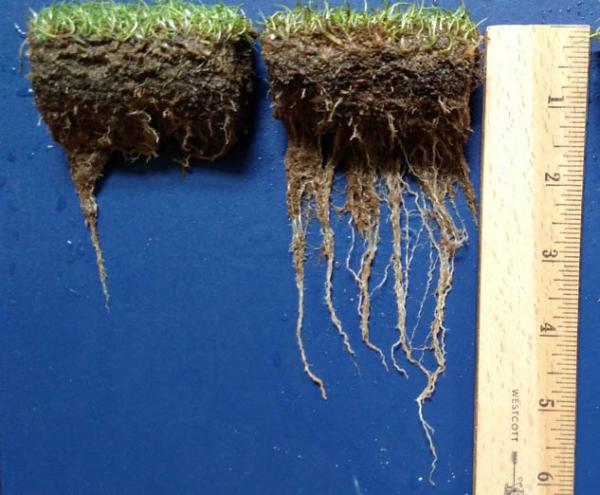A product initially developed to control nutrients runoff on Florida farmland could help golf course superintendents use less water and fertilizer. And a business-friendly climate at a major university has helped bring it to market.
 Rhizosorb is a soil amendment that when applied once annually during aerification can help golf turf retain water and fertilizer until they are needed by the plant. The proprietary controlled-release technology developed decades ago by Penn State researchers results in a healthier plant with promotes longer root growth, says Hunter Swisher, founder and CEO of Phospholutions, the start-up company that markets Rhizosorb.
Rhizosorb is a soil amendment that when applied once annually during aerification can help golf turf retain water and fertilizer until they are needed by the plant. The proprietary controlled-release technology developed decades ago by Penn State researchers results in a healthier plant with promotes longer root growth, says Hunter Swisher, founder and CEO of Phospholutions, the start-up company that markets Rhizosorb.A December 2016 graduate of Penn State's turfgrass management program, Swisher, 22 learned about the technology as a student, and said the original version of what now is Rhizosorb was developed by PSU researchers for runoff control in Florida, but never made it out of the testing process.
Swisher found research data on the chemistry dating back 23 years. That literature, he said, described the product's ability to limit fertilizer use. What the research didn't describe were the cost-saving benefits of using less water and less fertilizer and the overall plant-health effects.
Swisher decided to conduct some studies on his, and established four plots on Penn State golf course practice green under with varying treatments.
Swisher made applications of Rhizosorb in the fall, a time when soil samples showed roots on the bent/Poa green to be about 2 inches in length.
"He told me he could double the roots," said Rick Pagett, superintendent of the university's Blue and White courses. "In the spring he came to me and said 'you have to see this.' The roots (where Rhizosorb had been applied) were 4 inches long."
That was enough for Pagett.
All of us would love deeper roots, especially in the Northeast."
The Penn State courses have a mix of sand-based and native-soil greens. Swisher applied Rhizosorb to both and one of Pagett's vendors even applied some through a DryJect treatment.
Within months, the results were the same everywhere: in areas where the product had been applied, roots were twice as long as in untreated areas.
"I know it's only 4 inches compared to 2 inches," Pagett said. "But it did what he said it would do. It doubled our root length."
Today, the product covers about 6 acres of greens, tees and fairways.
"We're very excited," Pagett said. "We can't wait to see what it's going to do."
Mike McNamara also is testing the product on a much smaller scale on an ultradwarf Bermudagrass green at TPC Prestancia in Sarasota, Florida. He too was impressed with the initial results.
"As a Penn State alumni I wanted to help Hunter in any way that I could. We applied Rhizosorb to half of our Champion Bermuda nursery green after aerification," McNamara said. "We cut our irrigation run times down to stress the turf. The half with Rhizosorb had longer roots and displayed better drought resistance than the other half without the Rhizosorb. I would need to do some more testing but initial trial was encouraging."
Swisher was able to take advantage of some business-friendly entrepreneurial programs at Penn State that allowed him to start up Phospholutions and bring Rhizosorb to market.
"I was lucky enough to take a class and learn about this technology and why it never worked," he said. "We've been able to make it cheaper and more viable and get it to market."
By measuring out water and nutrients as needed, Rhizosorb promotes longer root growth as the plant searches for food and water. According to Swisher's studies, after three months turf treated with Rhizosorb had roots that were twice as long (6 inches compared with 3 inches) as untreated turf.
"Every inch below soil takes two times as long to dry out," Swisher said. "We can reduce water and fertilizer use by 15 percent in one application."
Pagett said he doesn't think he will be alone in looking for a tool that will help his bottom line and help him be a better steward of the environment.
"All of us would love deeper roots, especially in the Northeast," Pagett said.
"This could help superintendents reduce inputs. That's a home run for sustainability, and it could make superintendents' lives easier."

